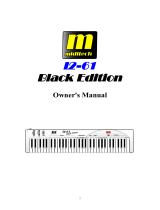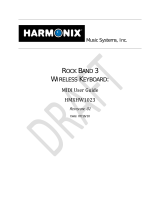
8
Transpose works in the same way as Octave Shift above, except the shift is +/- 12.
As with Octave Shift, there are two ways of transposing the keyboard. You can use the Octave “+” and “-” buttons, or the black keys F#
3
, G# 3 and Bb3. These black keys represent “TRANSPOSE -,” “TRANSPOSE 0” and “TRANSPOSE +,” respectively.
T
o assign the octave “+” and “-” buttons to transpose:
< P
ress the Advanced Functions button to get the keyboard into Edit Mode.
< Press the black key above D1 (named D# 1), representing “DATA = TRANSPOSE.”
< E
dit Mode will finish as soon as D# 1 has been pressed.
< P
ress the “+” key and you will hear the pitch of the note you play go up.
*A semitone represents the change in pitch from one note to another. So, changing two semi- tones is the same as playing a note two
notes higher.
Channel
MIDI data from the keyboard can be sent on any of 16 MIDI channels. However, certain MIDI devices and MIDI software requires the
keyboard to send data on a specified channel. If this is the case, you can change the channel the data is sent using the following method:
< Press the Advanced Functions button to get the keyboard into Edit Mode.
< Press one of the 16 channel keys from D1 to E3, whichever one represents the channel you need.
For example, if a device specifies that you need to send data on Channel 10, press the Advanced Functions button, and then key F2 to
select Channel 10.
The Channel can also be assigned to the Octave “+” and “-” buttons. This will increment through the channels. When Channel 16 is
reached and “+” is pressed, Channel 1 will be selected. If the Octave “+” and “-” keys are selected to vary the Channel, the lights above
the buttons will not change, since it is not possible to have a Channel with a negative value. Pressing both the “+” and “-” buttons
together will recall Channel 1.
Program Change
Program Changes are used to change the instrument or voice you are using. For example, let’s change the instrument to a bass sound.
To do this we need to send a program change of 32, which will select an acoustic bass sound from the General MIDI Instruments list
(see Appendix). There are two methods send the program change:
1. Incremental/Decremental Program Change:
< Press the Advanced Functions button.
< Press the black key above F1 (named F# 1).
< Now the Octave “+” and “-” keys can be used to change the program.
< Press “+” and continue to play some notes until you find the instrument you want.
2. Quick Select Program Change
< Press the Advanced Functions button.
< Press the black key above F4 (named F# 4), representing “program.”
< Pr
ess keys C4, then E3 then C5. This enters the combination: “3,” “2,” “ENTER.”
Alternatively, you can use the “+” and “-” buttons to change the value, and then press ENTER.
Now the keyboard is set to play the GM bass sound 32 (from the General MIDI Instruments standard list). The full list of instruments
accessible using program changes is given in the Appendix at the end of this manual.
Method 1 is useful if you want to cycle through different instruments to see which sounds best in your song, while Method 2 is more
useful if you want to select a specific number, as is the case here.
If the Octave “+” and “-” keys are selected to vary the Program number (Method 1), the lights above the buttons will not change, since
it is not possible to have a Pr
ogram with a negative value. Pressing both the “+” and “-” buttons together will r
ecall Pr
ogram 0, which
selects a grand piano sound.
Bank LSB and Bank MSB
Program Changes are the most commonly used messages to change instruments and voices. However, the number of instruments
accessible using Program Changes is limited to 128. Since some devices have more than 128 voices, they require a different method
to access these extra voices. Generally
, these devices use Bank LSB and Bank MSB messages, The Keystation 49e can accomplish
these changes in two ways and they ar
edesccribed following:















